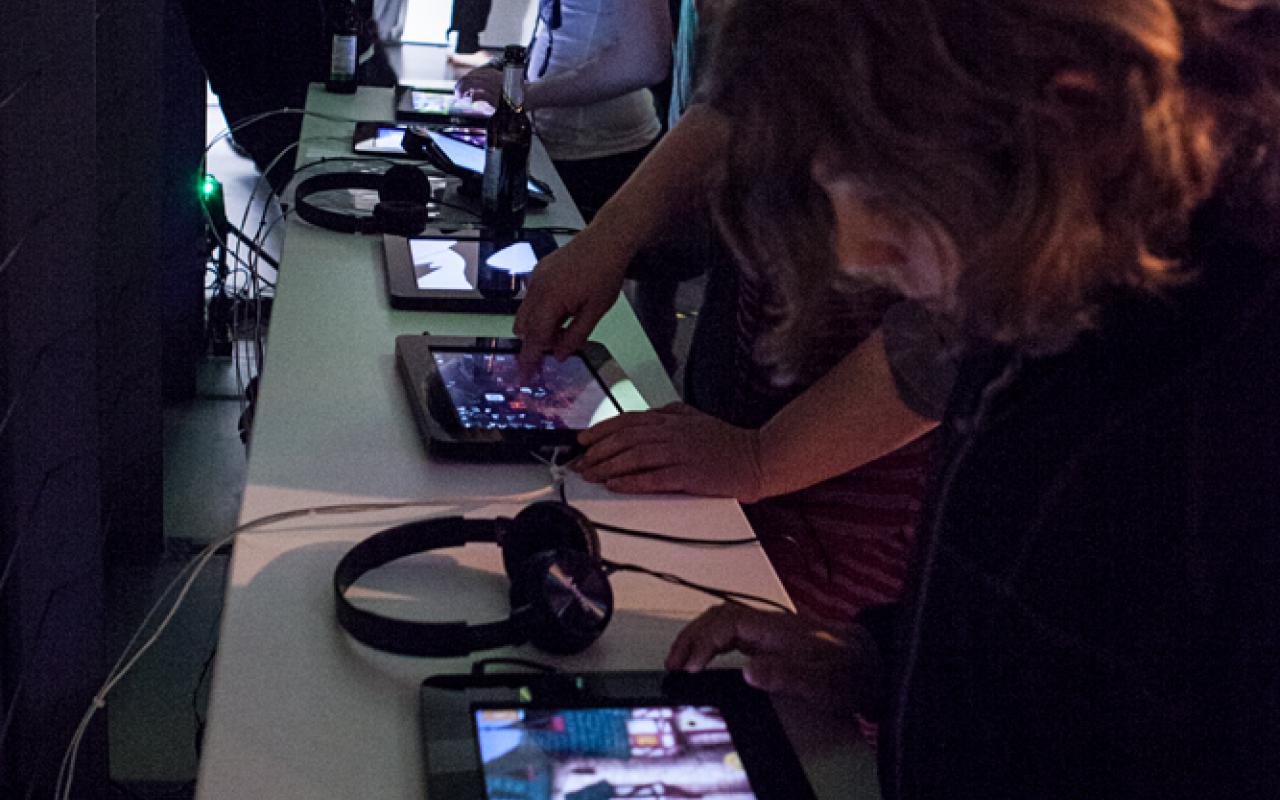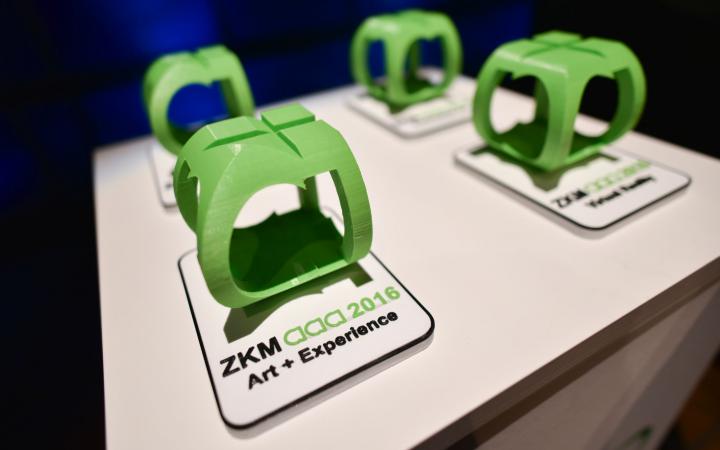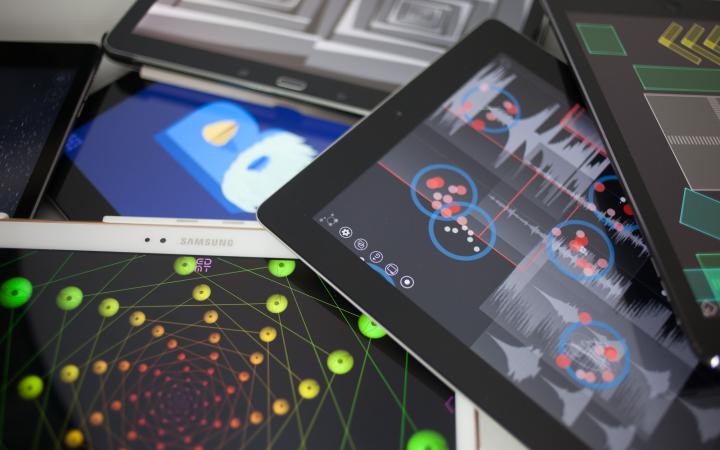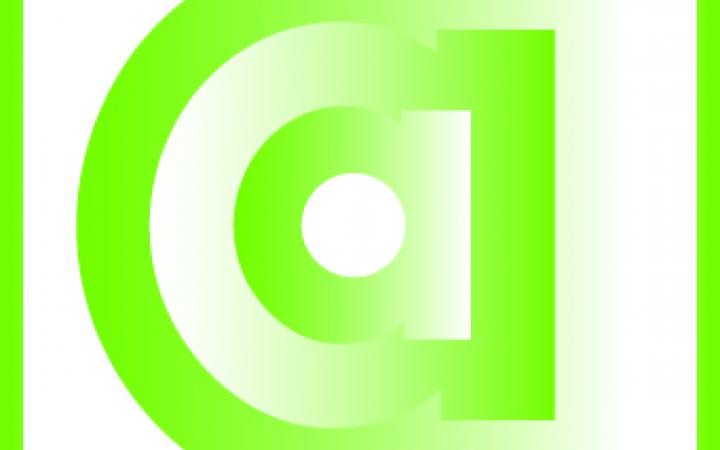
In 2016 the AppArtAward has been awarded for the sixth time. When it was inaugurated, back in 2011, only a few art apps existed in the universe of mobile computing, with its various app platforms. Now the app format has become a new, important form of distributing artistic productions. This year, around 92 apps from 17 countries were submitted for the AppArtAward. The winner apps of the AppArtAward 2016 as well as a selection of the best submissions can be tested at the ZKM.
The winner of the AppArtAward 2016
Special Prize for Connected Art: sacrificium
(Android, 2016)
by Joanna Dauner
»sacrificium« is an interactive installation which takes up the ritual of lighting votive candles and connects to them with a smartphone or tablet via an app. Candles or other lights are lit in many religions as act of offering prayers and as a symbol of contemplation. After the ritual the lights are left behind as substitutes for the persons who offered them, symbolizing their entreaties and prayers. sacrificium carries this ritual into the realm of the digital networks. For many people, taking a conscious decision not to use their device for a period of time is severely challenging. With this app, the ritual sacrifice consists in the users not using the applications on their smartphones for two hours. Instead, one can light a real votive candle in the chapel of St. James the Great in Fischbachau, Bavaria. This candle will burn for two hours if during this time the device is only used to look at the sacrificium livestream. However, if the running app is closed or pushed in the background, the candle in the chapel will be extinguished.
Special Prize for Sharing: thangs
(iOS, 2016)
by Sammy Schuckert
The app thangs provides a platform whereby one can share useful objects within one’s own network of contacts. The special feature of this app is that it allows direct access to the users’ phone book. When friends and acquaintances have also installed thangs, the app displays their loan requests for lawnmowers, drills, or butterfly nets. Via a linked website these requests can also be sent by free SMS to contacts who have not installed the app. thangs is a user-friendly app which facilitates communication and supports a more sustainable use of resources by encouraging people to lend rather than to buy.
Special Prize for Art+Experience: Mimics
(iOS, 2016)
by Fabian Schaub and Thomas Krüber
Mimics is a multiplayer game, which is based on the human capability for subliminal communication via facial gestures. We are experts in recognizing feelings that are expressed by the slightest changes in facial muscles and we constantly scan our environment for these changes. This talent, which every one of us trains our entire lives, constitutes the central mechanism of Mimics. The app offers a single player or a team a variety of images of facial expressions to be imitated. One side playing the game has to guess which of the images of facial expressions is being imitated by the other. Making faces and watching the facial gymnastics of the others is hilarious, but also challenging. For it is not simple to determine which of the images on offer is being imitated as most of them are quite similar.
Special Prize for Virtual Reality: Raum
(iOS, 2016)
by Sascha Haus
The virtual reality app Raum [space, room] confronts users with critical thoughts about the limitations and possibilities of simulation in virtual space. The first sequence takes users – equipped with smartphone and VR headset – to an office. A desk with a computer and a coffee mug suggests it is an authentic office environment. An off-screen voice asks the user to use the keyboard or move the mug – interactions which obviously don’t work. Eventually, after loud protests by the speaker, the space opens out. Guided by eye-tracking, the narrow confines of the office disintegrate, brick by brick, until the user is in a seemingly endless virtual world through which he or she begins to fly. The speaker is silent and the users can control the direction of their flight and encounter the virtual space afresh. The potential of VR is opened up not so much by merely simulating reality but by exploring technical possibilities creatively which enable new realms of experience.
More Highlights in the exhibition
A/D Clock
(iOS, 2015)
by Takemi Watanuki
A/D Clock is an app that focuses on the interface of the digital world (inside the computer) with analog reality. In this sense a clock has two faces: a digital display and an analog clockface. A/D Clock displays the time in digital format, that is, six numbers giving the hours, minutes, and seconds. However, these numbers are made up of 144 analog clocks, where the hands of the minutes and hours build the outlines of the six numbers showing the time.
Daemons
(iOS, 2016)
by Giulia Bowinkel
Daemons is about the fact that today, humankind lives in a world, which it largely created itself with the help of computers, and which it also controls. A coffee cup, cars, stock market prices, communications, research: in all these areas computer-aided models are used to simulate the various scenarios. Only in a next step these simulations are implemented in our real world – put into practice – and thus become the environment in which we live every day. Daemons plays with the connection between virtual simulations and actual reality: the app animates certain, predetermined images as soon as the camera of the device captures them. Here, the term Daemons is a double reference. For one, it refers to the computer processes also known as “Daemons,” which run in the background and are therefore beyond our cognitive reach. On the other hand it references the daimones, beings from Greek mythology, which embody the individual’s fate.
Rec All
(iOS, 2016)
by Romain Cazier
The application Rec All references the genre of the geometrical puzzle. The goal of the game is to teach a minimalistic, amoeba-like creature in every level a certain pattern of behavior, so that it can independently reproduce it and can pick up the desired objects, the “collectibles,” and negotiate obstacles. To begin with, the creature is controlled via the fingers so that it can perform the requisite movements for the first time and the first object can be collected. After this, the creature completes the track on its own by utilizing the “learned” skills. The more objects are collected, the more demanding the game gets, and the more dexterity is required.
SoundBow
(iOS, 2016)
by Agoston Nagy
SoundBow is a drawing-based music instrument with a clean and simple visual interface. Users can create music by drawing curves or lines on the screen and also forms through their physical movements. The graphic elements on the display can be moved around, which alters the sounds produced. The app also enables you to record your own sounds via the microphone. These can be used as samples, as a basis for creating melodies or soundscapes. You can also export your composition as an audio file.
Twisted Lines
(iOS, 2016)
by Daniel Helbig
The design of Twisted Lines is minimalist; it is a tactile puzzle which is impressive because of its unique playing technique. Although the game is simple it offers lots of scope for extensive and interesting moves in a new and mind-twisting game experience. Colored squares are dragged with the finger across the screen. Two parallel trails in different colors mark the way the square was moved. In the main, users have to follow just two rules: First, the players have to collect game points, “pickups,” which can only be collected if these have the same color as the square that was moved. Second, when the player drags a pickup across trails, its color changes to that of the trail crossed first. While players try to find the right route to solve the puzzle, their moves make the music and colors change, creating fascinating patterns in the process that can be saved and shared with friends, for example, via social networks.
variant:flare
(iOS, 2016)
by Joshue Ott and Kenneth Kirschner
variant:flare is an audiovisual artwork that creates beautiful music and imagery. The app combines user input and built-in randomness to create images and music that continually change, grow, and evolve, offering a new and different experience every time. For users of all ages, variant:flare is a chance to explore and experience a unique work of generative art. The visuals, in turn, are controlled by the sound, so by changing the music, you influence the development of the visuals. The user’s compositions can be saved to the photo gallery of their device and thus can be retrieved again at any time.
- Credits
- Stefanie Fritz (Curator)
- Volker Sommerfeld (Curator)
- Exhibitions team
Project management: Stefanie Fritz
Technical management: Volker Sommerfeld- Organization / Institution
- ZKM | Karlsruhe






